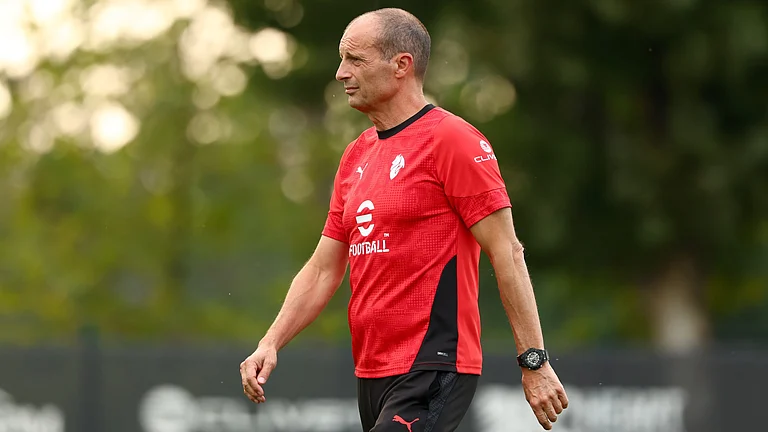Chunri wale mataji is a misnomer. For, there is neither a mataji here, nor does anyone drape a chunri. But that 82-year-old should be called by this name is not the strangest thing that has happened in these parts. Jani, who lives in the hills above the Maa Ambe temple for which this Gujarat town is famous, claims to have not had even a morsel of food or a drop of water for the last 70-odd years. What’s more, he says he hasn’t passed urine or stools in these decades.
Is he a miracle man or someone with knowledge of esoteric survival and body-control techniques? To the few thousands who revere him, the answer does not matter; he is, in a strange transference of time and gender, Maa Ambe personified. To scientists, he presents a rare challenge: how exactly does a human body thrive without food and water, and without performing excretion, for such an extended period?
The science behind this seeming miracle should be revealed over the next few months as a high-powered team of scientists of the New Delhi-based Defence Institute of Physiology and Allied Sciences (DIPAS) analyses reams of clinical data and readings. These were taken earlier this month at Ahmedabad’s Sterling Hospital, where Jani agreed to be the subject of a unique 15-day observation study, one backed by cctv monitoring and 24-hour surveillance to ensure that he did not break his own strict rules.
This was Jani’s second such stint. In November 2003, he was observed for ten days by a team of doctors led by Sudhir V. Shah, an eminent neurophysician keen to decode the science behind fasting and meditation. Jani’s “no food, no water, no ablutions” claim was found to be genuine then, as it was by DIPAS this time. Then, as now, a battery of tests had been carried out on him. “The only condition he set us was that we should not conduct any invasive procedure,” says Dr Shah. “We respected that.”
As Jani’s devotees tell it, DIPAS scientists and doctors began as sceptics but were dumbfounded on several occasions, such as when they requested Jani for a 50 ml urine sample. He expressed that exact amount from the 100 ml in his bladder and appeared to absorb the rest within. “On the last day, many scientists called their families to seek mataji’s blessings. If scientists did that, there must be a divine shakti, must there not?” asks Kailash Joshi, a Mumbai-based businessman and follower.
The lore has it that Jani, inclined towards prayer as a boy, was denied permission by his mother to take to spiritual life. “Then, one day when he was around 11 years old and in meditation, Maa Ambe came to him and told him to follow the spiritual path,” says Bhikabhai Prajapati, a retired schoolteacher and Jani’s devotee of 40 years. “She also asked him to suck her thumb, saying that after this he would never need other sustenance. At 13, he completely stopped eating. As he completed his siddhis, his attire changed. Maa asked him to dress like her. That’s why he only wears a sari-like gown, with a nose ring, earrings, bangles and anklets.”
He also meditates for days on end in his cave above Ambaji town, emerging only to pray to goddess Ambe, whose original abode, Mount Gabbar, according to folklore, is opposite his cave. “We draw energy from food, mataji gets energy from everywhere—plants, air, the sandstone of the caves, rain, everything. That’s why he has always lived in caves in deep forests,” says Prajapati.
Jani’s fame was initially restricted to Ambaji and its environs but gradually spread to Ahmedabad and Mumbai. Equally, his lifestyle too changed. From continually inhabiting his cave, with bears and leopards (it is said) for company, Mataji was persuaded to spend more time in a marble and asbestos structure constructed at its mouth. Inside this ‘ashram’ is a shrine dedicated to Maa Ambe, next to which stands a smaller shrine with Mataji’s idol in marble, worshipped with full ritual twice a day. And right next to it stands an over-ornamented jhoola on which mataji sits or reclines when not in his cave. “We sealed off the adjoining caves. There are too many snakes underground,” says Joshi, a sceptic-turned-convert and now an inner-circle member.
When not in meditation, Jani apparently cleans his cave and “ashram” thoroughly, orders around a small group of devotees, and flies into a temper if things don’t go his way, especially on full moon nights, when devotees abound. “We have all been in his firing range,” says Joshi with a grimace. Recently, a young girl who strolled into his shrine in a revealing top got a taste of his spleen and had to cover up. His short fuse is not the only sign that this claimed divinity has a human side. Reclining on his jhoola on a steamy May afternoon that recorded 44 degrees Celsius, while we interviewed him, he suddenly asked for a wet turkish hand-towel to be draped over his head. Even Mataji needed some worldly respite from the oppressive heat.


























